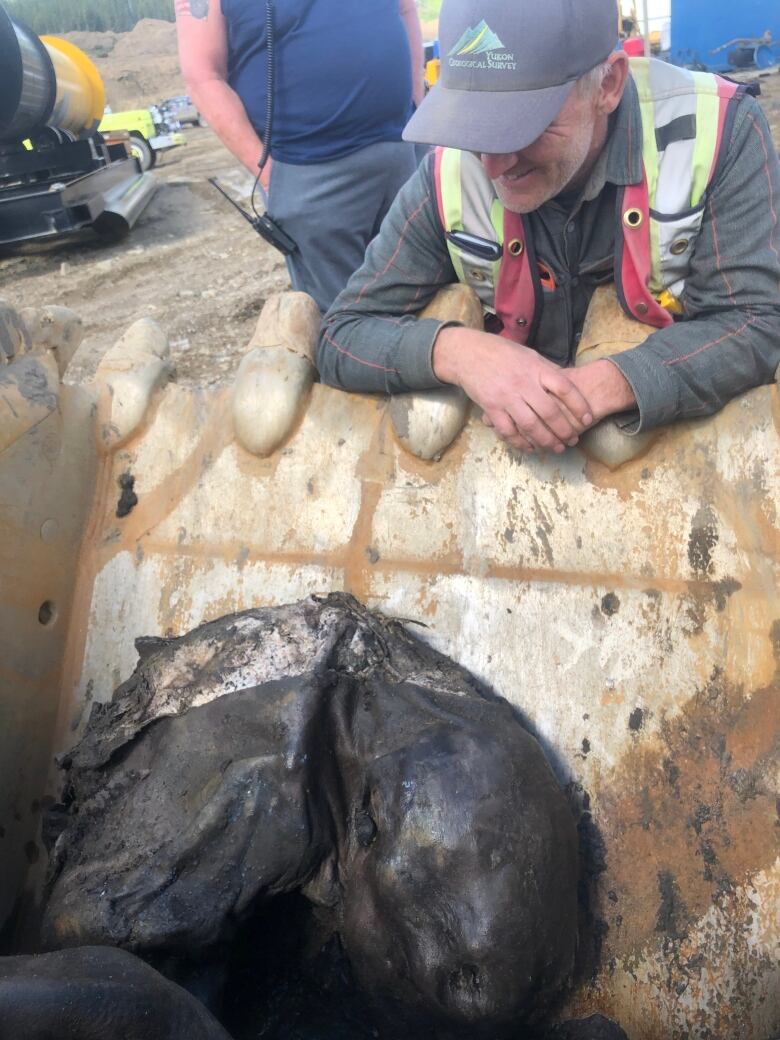[ad_1]
More details were revealed Wednesday about the discovery of Nun cho ga, the first near-complete baby woolly mammoth found in North America by a miner in Yukon’s gold fields last month.
The rare specimen made headlines around the world — and sparked wonder and excitement among local scientists in Yukon and the Trʼondëk Hwëchʼin First Nation on whose land she was found.
Turns out it took the perfect storm to find her.
Scientists believe Nun cho ga, which means “big animal baby” in the Han language of the Trʼondëk Hwëchʼin First Nation, died quickly sometime between 30,000 and 35,000 years ago.
They believe that in order for her to be so well-preserved, a storm likely buried her, shielding her from the elements and other animals.
On June 21, the day she was found, Jeff Bond of the Yukon Geological Survey just happened to be in Dawson City, Yukon, a little less than two hours’ travel from the site where Nun cho ga was found.
Dr. Grant Zazula, a government of Yukon paleontologist, had heard from Brian McCaughan, the owner of Treadstone Equipment, earlier that day about the discovery. Zazula, who was in Whitehorse, was looking for someone to go on site to retrieve the baby woolly mammoth and bring it safely to cold storage in Dawson City.
Bond readily obliged when he saw the email around 2 p.m. and headed to the site with some of his colleagues, a researcher from the University of Calgary, and two of his students.
When he arrived, he saw that McCaughan and Travis Delawski, the placer miner who found the mammoth, had it well protected so Bond decided to document the site’s geology by taking samples of the sediments.
Within a couple of hours, he noticed a storm coming up their way. And then it hit.
“You get violent thunderstorms now and again in the Klondike, for sure, but this was another level,” said Bond.
“The lightning bolts were dropping around us,” recalled McCaughan. “We shut down the crew. I shut everything down. It was just pouring, I don’t know how long but we were just drenched.”
“That was surreal and significant,” McCaughan said.
They all drove to the crew quarters at the mine site and discussed whether they should wait for the storm to stop or go back to Dawson City right away. They decided to drive to Dawson City.

“I think back about the significance of that storm,” said Bond. “It was a message to get going, to get the mammoth on the road, to get it back to a secure situation where we could get into cold storage as quickly as possible.”
“And so in a way, I think it was speaking to us.”
Driving back, and once he was in cell phone range, Bond contacted Zazula who had already found a location in Dawson City where the rare specimen could be put safely in cold storage.
It was more than a bunch of lucky coincidences, added McCaughan.
“The miracles that took place just for us to get it out the way we did, is a miracle in itself, never mind how it was preserved, how it passed away, the day that it happened, you can’t even describe how many miracles happened for this to be here,” he said.

Debbie Nagano, the heritage director of the Trʼondëk Hwëchʼin First Nation, agrees.
After hearing about the discovery from Zazula that same day, she went to Dawson City to gather the elders and get some guidance from them, and from Trʼondëk Hwëchʼin government’s council.
The First Nation had never found anything like this on its territory before and the elders decided Nun cho ga needed to be blessed.
“It was in the freezer but we wanted to protect it more,” explained Nagano.
Chief Roberta Joseph was there, as well as some elders and youth, representatives from the Yukon government, including Bond, and Treadstone Equipment.
Nun cho ga was taken out of the freezer, and the tarp in which she was wrapped was removed. Nagano said they stood in silence for at least four or five minutes, after which a ceremony was performed and Nun cho ga was blessed.
“It was quite emotional,” said Nagano.
For Bond, the ceremony helped him connect emotionally to the baby woolly mammoth.
“[It] opened my eyes to that and it certainly has become apparent that this animal died in a storm event,” said Bond.
For now, Nun cho ga will remain where she is, on the traditional territory of the Trʼondëk Hwëchʼin.
Nagano said the first step toward a long-term plan for Nun cho ga will involve getting direction from the First Nation’s executive director, chief and council, and elders, and then work with other partners.
“Lots of different stakeholders will be at the table and hopefully we can come up with some really good solutions and a different way of working together,” she said.
Brian Groves, senior manager of heritage for the government of Yukon, said his department has been working for many years with Yukon First Nations and is in no rush to determine next steps with Nun cho ga.
“There’s time to talk about this and come up with a plan. So really the next steps will be determined here in collaboration,” he said.
[ad_2]
Source link



